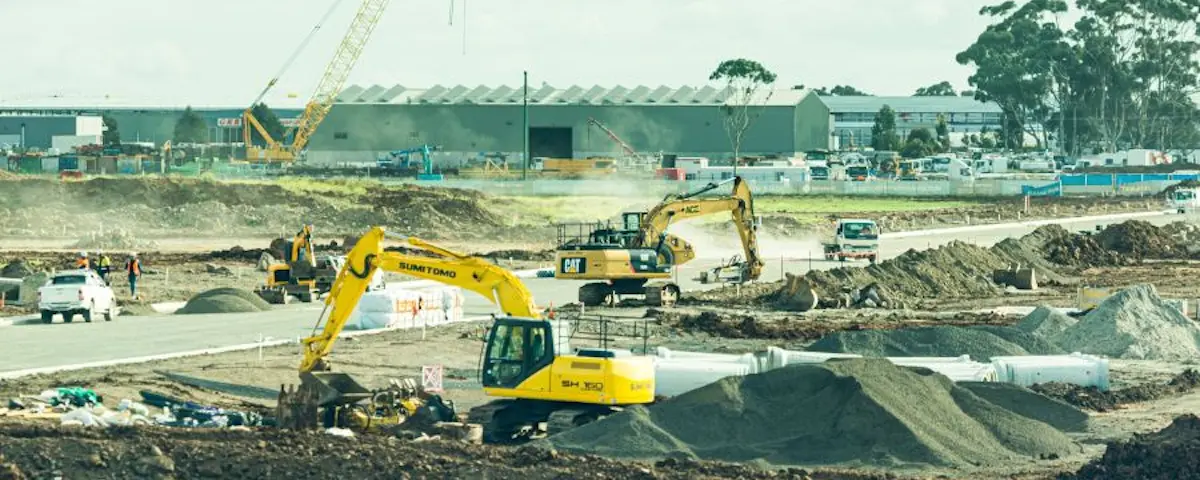IoT in Construction Industry

The Internet of Things is utilized in the construction industry to improve efficiency, cut waste, raise safety standards, and save time and money. In specific sectors, including building and construction, telematics is used interchangeably with the Internet of Things (IoT). Telematics, or the Internet of Things, allows users to monitor vital evaluation data about their equipment, such as idling speed, tire pressure, and GPS location.
Let's look at some of the more concrete ways in which the Internet of Things is finding its way into the construction zone so that we can better understand how it all works in the industry.
Everything about a structure, from how people live to how businesses are operated to the materials used in its construction, is being transformed by the Internet of Things (IoT). Modern buildings are surrounded by a vast ecology, almost all of which has been modified in some way.
The Benefits of Internet of Things Technology in the Construction Industry
If the "Internet of Things" means linking disparate entities, including people, the building sector is currently actively doing so. Many building sites have Internet connectivity, turning them into interconnected workplaces.
There's more to them than just a novelty factor. Connected gadgets on construction sites provide several benefits for the project, the companies, and, most importantly, the workers. Numerous construction-related IoT applications are discussed in depth. Learn how IoT can facilitate smart asset management for a building company.
The following are some potential ways the Internet of Things might impact the building industry: (IoT). This sampling of IoT applications might be used in the building industry.
You have a lot of information to choose from
Today's most cutting-edge systems can keep tabs on fluid temperatures, engine loads, pressures, and other vital functioning signs. Because of the software being utilized, many of these details are shown. Having the most cutting-edge tools in data analytics will lead to more reliable predictions and reduced downtime.
Smart gadgets
Incorporating high-tech devices into a house or company makes the location seem more modern, up-to-date, and communicative. Since there are more connected gadgets than people, it is now possible to obtain information from objects with higher accuracy. In addition to digital power meters and circuit breakers, thermostats are another specific piece of equipment that may be used to track energy use. By addressing issues as soon as they develop, facilities managers extend the useful life of any building by avoiding the need for expensive, extensive repairs down the road.
Better protection for employees
A small minority of workers in the industry do not have smartphones. Several businesses have strict laws regarding the usage of mobile phones to protect their personnel. Contrarily, many employees have installed safety apps, such as a fall detector, that run in the background regardless of whether or not the phone is actively being used.
The user's emergency contacts are notified in the same way as with a wearable device in the event of a fall. There is a broad range of possibilities for increasing one's safety with the help of wearable technology. Some of these are standalone items that the employee must always have on them. Some of these features are standalone, while others are integrated into more significant pieces of PPE. All of these devices monitor employees' vitals to detect potential health problems and prevent accidents before they happen.
Constant reporting
The data collected at the location allows for instant updates shared with everyone back at the office. Project stakeholders may get daily, weekly, or monthly updates through electronic reports, data delivered directly to the BIM, drone footage, or internet-connected video cameras.
Connected devices abound on the building site, sending information back to the office in near real-time. Thanks to real-time reporting, stakeholders may assess the project's progress and make adjustments as needed to keep it on track.
Automated procedures
Sensors and radio frequency identification (RFID) tags affixed to equipment and materials might facilitate a preventative approach to purchasing supplies and performing maintenance. Before a piece of equipment is checked out to a client or sent to a job site, an employee gives it a thorough once-over. An employee will get a warning from the system when the stock of a particular item drops to a critical level, at which point the employee will be prompted to place an order for more of that item.
The structure that lasts for a long time
Digital power meters, intelligent thermostats, and circuit breakers are tools available to building operators to keep tabs on energy use. When anomalies are discovered, immediate notifications are made to the relevant people. When a building is connected to the Internet of Things, its various systems can be monitored more proactively, which increases the structure's lifespan. As a result, site managers can respond rapidly to any problems that develop, avoiding the potential for more damage and increased costs.
Continuously better
Data collected by the IoT is its most prized possession. But how can we use this data to improve our lives? Companies use the information for internal improvement. Based on the data analysis findings, the operations team may tweak some of the most critical processes to speed up project completion.
Distantly Regulated
In theory, remote commands might be transmitted to any internet-connected gadget. This viable option should be considered when machines have to work in locations where human health is at risk due to pollution or other factors.
Garment-based technology
Many forms of wearable technology and gadgets may find significant use in the building industry. When we talk about "wearable technology devices," we're referring to any item that can be attached to a person in some way and used to facilitate the transfer of data between the person wearing it and the device itself.
Sensors that keep tabs on employees and their surroundings are just one example of the sort of technology that may help make workplaces safer for everyone.
Checking up on the Stock of Tools, Materials, and Inventory
One of the greatest benefits of the Internet of Things for the construction industry is the capacity of linked devices to deliver granular information about people, construction equipment, and tools.
Time lost is equivalent to money lost, and vice versa. However, if RFID and sensors are included in the machinery and tools, the time and money needed to do a project may be drastically reduced. This is precisely why integrating Internet of Things technologies into heavy machinery is so important.
Data Representation for Construction Projects in Building Information Models (BIM)
Another component of the internet of things (IoT) that is becoming an increasingly important part of building and construction is building information modeling, sometimes known as BIM.
Conclusion
Radio-frequency identification (RFID) labels can track the quantity of stock on hand, and an onsite system can tally the total. When a certain threshold is reached, the system may automatically initiate a request for more instances from a centralized system. Less time is wasted idle, and tasks are more likely to be completed on time.
Explore more
Need any help in IoT?
Need any help in IoT? An Atreyo expert identify the right solution for your needs.
If ready to talk to an Atreyo expert
Interested in IoT products? go to







